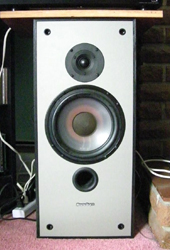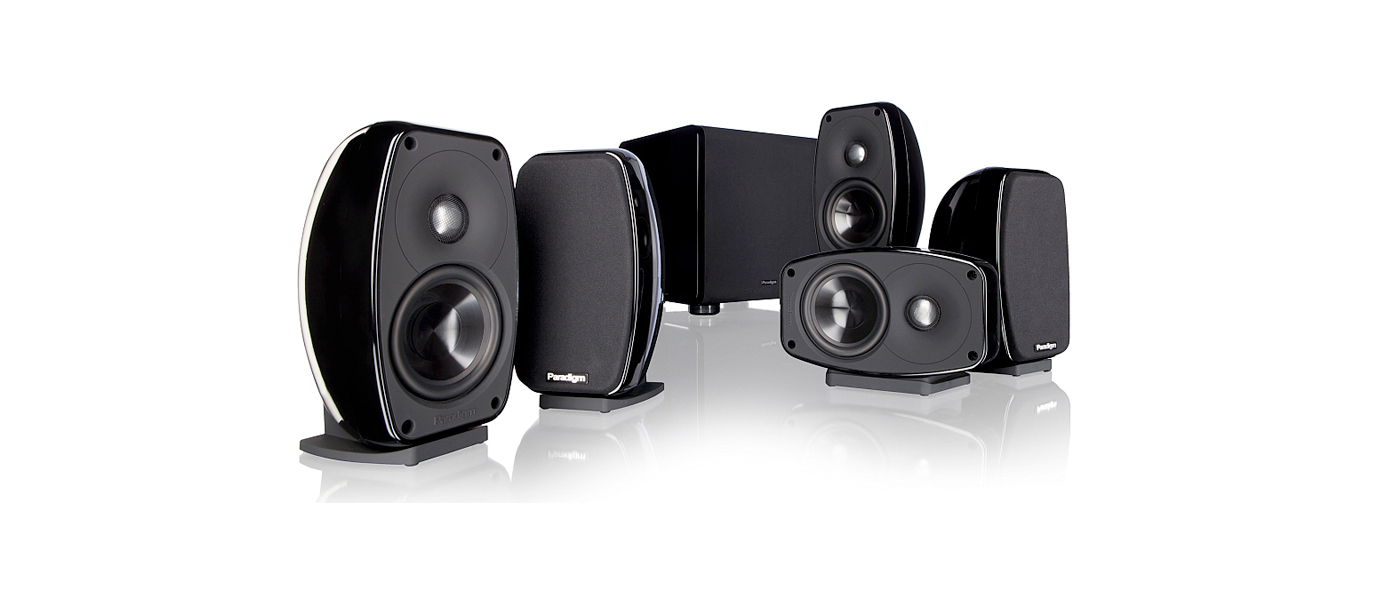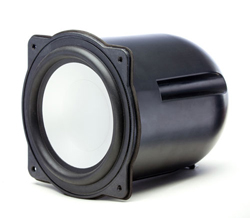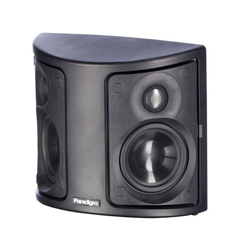
“Monitor 7se, purchased mid 1980’s, still sounding excellent”
Introduction to the Paradigm Monitor 7 Series Speakers
When it comes to consumer electronics I must admit I am of two minds. On the one hand I really do enjoy the hobby, being able to assemble high fidelity motion picture and sound presentation systems in the home. On the other hand I simply abhor the planned obsolescence of it all, things like AV receivers which, literally, are “outdated” within a year. Speakers however are one of the last bastions of long term value and investment. Simply stated, good speakers will never be obsolete. My father has a pair of Paradigm Monitor 7se speakers which are almost 25 years old… and not only are they in great shape, but are still an enviable, excellent sounding pair!
PARADIGM MONITOR 7 SERIES SPEAKERS SPECIFICATIONS
Mini Monitor
- Design: 2-way Ported, Quasi-3rd-order Resistive Port, Bookshelf (Monitor)/Stand-mounted
- Crossover: 2nd-order Electro-acoustic at 2.0 kHz
- Drivers: One 1″ Dome Tweeter, One 6.5″ Mid/Bass
- MFR: On-Axis, ±2 dB from 75 Hz – 22 kHz 300 Off-Axis, ±2 dB from 75 Hz – 18 kHz
- Sensitivity: Room / Anechoic: 90 dB / 87 dB
- Suitable Amplifier Power Range: 15 – 100 Watts
- Nominal Impedance: 8 Ohms
- Dimensions: 13.5″ H x 7.6″ W x 10.5″ D
- Weight: 17 Pounds/each
- Finishes: Black Ash, Heritage Cherry
- MSRP: $279/each USD
Center 1
- Design: 3-way, Sealed Enclosure
- Crossovers: 2nd-order Electro-acoustic at 3.0 kHz; 2nd-order Electro-acoustic at 550 Hz (Bass Drivers)
- Drivers: One 1″ Dome Tweeter, One 3.5 Midrange, Two 5.5″ Woofers
- MFR: On-Axis, ±2 dB from 75 Hz – 22 kHz
- 30? Off-Axis, ±2 dB from 75 Hz – 18 kHz
- Sensitivity: Room / Anechoic: 92 dB / 89 dB
- Suitable Amplifier Power Range: 15 – 120 Watts
- Nominal Impedance: 8 Ohms
- Dimensions: 7.25″ H x 17.75″ W x 10.5″ D
- Weight: 25 Pounds
- Finishes: Black Ash, Heritage Cherry
- MSRP: $379 USD
Surround 1
- Design: 2-way, Sealed Enclosure
- Crossover: 2nd-order Electro-acoustic at 2.0 kHz
- Drivers: Two 1″ Dome Tweeters, Two 4.5″ Mid/Bass
- MFR: : ±2 dB from 120 Hz – 20 kHz (bi-directional Soundfield)
- Sensitivity: Room / Anechoic: 88 dB / 85 dB
- Suitable Amplifier Power Range: 15 – 100 Watts
- Nominal Impedance: 8 Ohms
- Dimensions: 8.5″ H x 9.25″ W x 5.1″ D
- Weight: 7.25 Pounds/each
- Finishes: Black
- MSRP: $279/each USD
- Paradigm
- SECRETS Tags: Paradigm, Monitor, Speakers
Just think, the speakers you buy today could be with you several decades from now. Even those enthusiasts with upgradeitis realize long term value: my brother passed down his legendary Paradigm Monitor 70P speakers to his deserving son when he stepped up to a Paradigm Reference ensemble, and those 70Ps are still being enjoyed by his progeny some 15 years later. For my part I actually regret selling some truly classic speakers I’ve owned over the years in order to finance new ones, but thatís a double edged sword: the excellent resale value of good speakers make such prospects truly tempting.
Even though I think that the 2nd generation Monitors, or 1st generation Reference speakers could still sell well against current competition, Paradigm is not content with the status quo. You see, they are not just experts in the field of loudspeaker design and technology, but they have also become masters of manufacturing. Its not enough to come up with a good speaker if you canít also reproduce it to within a half dB on the assembly line at a price real people can afford. Thanks to this, Paradigm continues what they call trickle-down technology. They spend R&D at the top end of the performance spectrum yes, but they also spend it reapplying said technology to their mid and entry level lines, which bring us to the subject of today’s review: the recently launched 7th generation Monitor series.
The Technology of the Paradigm Monitor 7 Series Speakers
The Monitor Series 7 lines includes an impressive array of models ranging from miniscule 2-way bookshelves to 5-driver floor standing towers along with several dedicated centre and surround models to chose from. The technology in them is common across the line so we’ll have a look at the broader picture before dialling in to the specifics of our review set.
Speakers are mechanical devices subject to the laws of physics in our world. Make no mistake loudspeaker design is very complex, yet there is a baseline of “equations” to it all. What sets one manufacturer apart runs the gamut, but when it comes to the product itself driver technology is everything. Anyone can put a driver in a box, but not everyone can make an excellent driver. While in the humble early years Paradigm was more of an assembler than manufacturer, buying OEM drivers and implementing them in their designs, for the bulk of their history they have manufactured all their own drivers. From the winding of voice coils, to the moulding of cones, to the by-hand assembly of it all. With the Series 7 Paradigm takes a deeper step into outsourcing their manufacturing: long time fans may notice with some concern the conspicuous lack of the “Made in North America” sticker on the box (“…to stay competitive” is of course the sited reason for the shift). Paradigm still designs and prototypes their drivers in Canada, but while mass manufacturing has been handed over to someone else, it is still their design and process which is being duplicated over yonder.
In terms of the drivers themselves, Paradigm has for over a decade now focused on metal dome and cone materials for their transducers. The ideal material in driver design terms is one which is both perfectly stiff and insanely light. Those of us with a few more years under our belts will recall when paper was pretty much the only material, then fabric became all the rage for tweeters and plastics took over the larger drivers. Metal really didnít take off until the past decades because of the one other property you want the material to have: no resonance. Early metal cone/dome efforts were challenged by the materials propensity to want to “ring”. But that was then and this is the second decade of the new millennium. In the Series 7 Paradigm has brought in aluminium to replace previous tweeter’s titanium while the aluminium mid/bass driver and midrange is right out of previous Reference series generation.
“Oversized magnet” is a bit of a marketing pitch (who decides what size you go over to be oversized?) but even a casual glance at the backside of one of the tweeters shows a decent motor structure. Likewise the mid/bass is of impressive build with its glass reinforced polymer basket. I was once asked to break one during a factory tour and it wasnít the fact that I couldnít break it with just my two hands (I’m no body builder) but rather the sheer rigidity of a “plastic” basket is what impressed me.
Cabinets is something everyone likes to wax poetic about. The bottom line is you want something which is solid and inert without adding unnecessary cost and/or weight. Paradigm has been designing and manufacturing boxes for so long its a no brainer they know where to put the emphasis: even on the smallest bookshelf in the series the front baffle is a full 3/4″ MDF and the tower models in the series have internal bracing. The finish is consistent with the value position of the series: no wood veneers but rather your choice of very well done black or dark cherry wood-grain vinyl wrap (go for the dark cherry!).
The Paradigm Monitor 7 Series Speakers Review
Our particular review set consists of the very flexible Mini Monitor mains, the compact but very high performance Center 1 for the centre channel, and the Surround 1 task-specific dipole surrounds.
The Mini Monitor is the proverbial 2-way 6-incher, a format which has been seen in innumerable speakers over the years from affordable models for budding audiophiles to very high end ones worthy of reference status (and not always with an accompanying sub-woofer). The tweeter crosses over to the woofer at 2 kHz, this being somewhat below the typical. That avoids the inherent challenges a 6 inch driver faces with the upper end of its useful range, but it also means Paradigm has to make the tweeter that much more robust. As with virtually all of Paradigm’s conventional speakers the Mini Monitor is a vented alignment with port at rear which we expect to exhibit the telltale deep but then sharp rolloff. The drivers are mounted from the inside of the cabinet which gives the front a very clean appearance with no screws visible. Neither are there fasteners for the included gills which instead attach by magnet so if you like the look of a grill-less speaker, these definitely will look like they were designed as such. In addition to the port, on the back we find a single pair of binding posts. At first glance the nuts appear plastic but they have a metal core so you can get a nice tight grip on a spade if you chose.
The Center 1, like so many other Paradigm center channel speakers, is a superb product: compact yet still a true 3-way. The tweeter in the middle crosses over to the midrange below it at 3 kHz, which in turn crosses over to the pair of woofers to either side at 550Hz. Not only does this embody all the virtues of a true 3-way, but it does so with virtually no off axis combing, the woofers being very close together to begin with and voicing only up to a relatively low frequency. The midrange is “protected” from the backpressure of the woofers by being in a sealed volume of its own.
The woofers themselves are a more traditional polypropylene versus the aluminium because the spectrum they play in does not benefit enough from the more expensive material. A pair of ports on the back reveal the vented nature of the design and like the Minis the front has the super clean appearance should you elect to forgo the grill.
The Surround 1 carries on a very long lineage of dedicated dipole surround speakers. Unlike my incumbent ADP-270s with their drivers a full 180 degrees from each other, the Surround 1s have a shallowed angle to the poles. Not only does this enable the attractive curved appearance, but in giving them a little more direct sound to their mix it may yield a more even presentation to multiple rows of seating. The pair of tweeters and 4 1/2″ mid-bass drivers are squeezed into a remarkably compact enclosure, smaller than some sconce lights I’ve seen. Wall mount hardware is included, suitable for drywall attachment, though catching a stud is always preferred. The binding posts are suitably recessed for wall mounting but use of something like bananas will still require an accommodating hole in the wall. In addition half-sphere rubber feet are provided should you need to place them on a shelf or other horizontal surface.
The Paradigm Monitor 7 Series Speakers In Use
When I first received the Mini Monitors ahead of the other pieces, I dropped them into my system as a stereo pair and was floored. This is Paradigm’s entry level 6-incher?!? Then the rest of the set arrived and things really started cooking.
On the whole Paradigm has over the years earned a reputation for a sound which can be a little aggressive at the top end of the treble, though in my experience this comes more from the preponderance of acoustically overly bright rooms in most homes. Here though I found little trace of superfluous spice, just super clear, articulate, and accurate treble. Even some notoriously bright tracks were highly listenable at elevated levels.
The critical midrange was well served by the Mini Monitors as a stereo pair, testament to their mid-bass driver’s upper end and the speaker’s crossover implementation. The Center 1 bested them though, as well it should with its dedicated midrange, delivering dialogue of even some challenging dated movie mixes with surprising intelligibility. In a way this comes at a price in that poor tracks are truly exposed for what they are but while lesser speakers simply blur everything, the Center 1 is your best chance at making the most of whatever you throw at it. With modern, responsibly mixed track, or even the most complex, crowded ones, the Center 1 not only keeps up, but veritably and almost single handedly, sells you on whole thing! Although you could run the Center 1 full-range and probably do it no harm, its response is ideally suited to being high passed somewhere around 80Hz. Doing so, coupled with its decent efficiency, will ensure plenty of headroom.
Interestingly, after trying the Mini Monitors on their own, I elected for the bulk of the review period to do without my subwoofer. The Mini’s have what can only be described as remarkable bass for their enclosure and price. I’ve heard other speakers this size with comparable bass, but they were at least twice the price. It will of course come down to acoustics, but in my dedicated home theater useable bass was dipping into the high 30s, and seemed unfettered by elevated output levels. While they cannot possibly deliver the same concussive deep bass only hundreds of cubic inches of displaced air can, they admirably reproduced the double bass of modern jazz recordings and cleanly, if perhaps reservedly, handle the rumblings of contemporary action movie mixes.
Surrounds are speakers which over the years have gotten an ill deserved outlook as being less critical. “Any speaker will do” is the bad advice I often overhear being given out. Since my earliest toyings with surround sound I have been a vocal advocate of dipole speakers for the surround (or rear) channels, and Paradigm has always been on-side with me on this one. Surround sound is a very delicate trick we play on our mind/ear. The artists who weave these tracks do so in dubbing stages and studios whoís surround hardware exhibit a very wide, diffuse sound, most commonly through an array of speakers. It does the track a disservice to pipe it through a single conventional speaker such that it calls undue attention to itself and pinpoints something which was meant to be broad. Forgive me for the preceding sidetrack but it was necessary to put into perspective my enthusiasm for the Surround1. I set them as if they were the main left/right (with the nulls pointed at me) and listened to some stereo music. What I heard was crisp, articulate sound, still with a semblance of positioning but extremely broad. This is exactly what we want! Placed where they belong, Paradigm’s dipole surrounds emulate the sort of sound emitted by an array of surround speakers and do so with excellent fidelity. You still get a sense of localization, but instead of it being right there, its more somewhere over there, as it should be. From delicate ambiance to full soundstage press, Iím hard pressed to fault the Surround 1s in any way. It might sound cool the first few times to hear overly localized effects, but thatís a novelty, not high fidelity. The more subtle soundfield of the Surround 1s is simply, dare I say it, “correct”. As it typical with dipole speakers the Surround 1s are not exactly efficient and have little bass, both of which are somewhat inconsequential but its worth mentioning they really should never be high passed at less than 80Hz.
Conclusions About the Paradigm Monitor 7 Series Speakers
With literally over a hundred speaker brands at CES and CEDIA, you can almost throw a dart and find good sound (as long as said dart didnít pierce a driver). But to do so at a price point, thatís what continues to amaze me time after time with Paradigm. While I am personally not thrilled they had to finally concede to outsourced manufacturing, there is honestly nothing in the product which gives it away. The Mini Monitors are an instant classic, the Center 1 is so very hifi that I wonder what three would be like as an L/C/R set, and the Surround 1 continues the legacy of delivering the best surround sound field you can put into a home theatre.
The Series 7, like so many Paradigms before them, are speakers which have the potential to become heirlooms!







